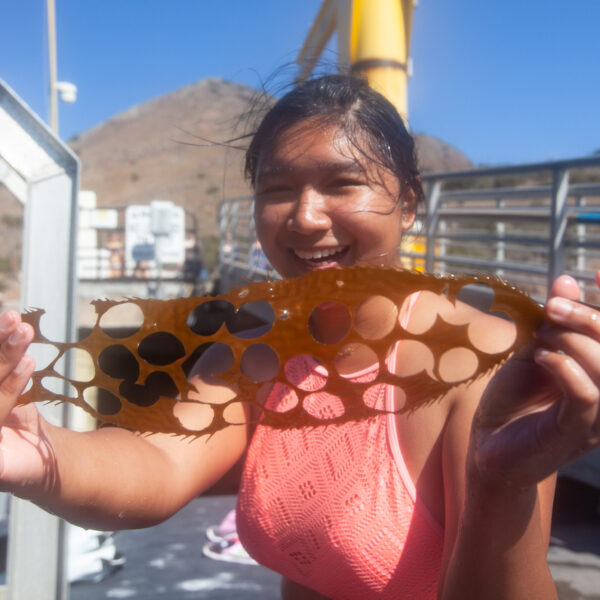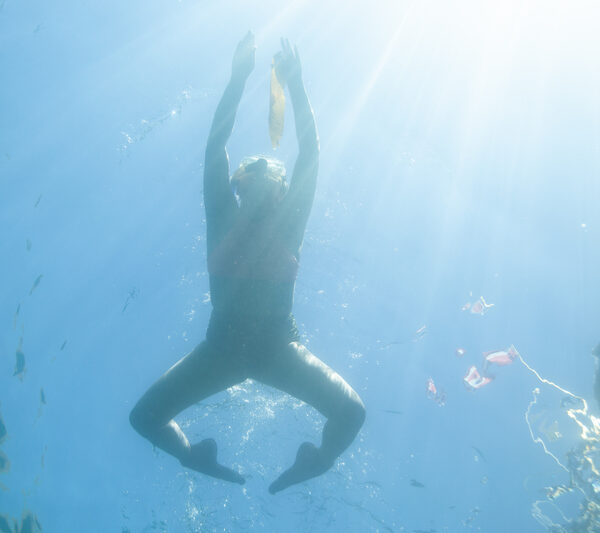Clock regulation and age in giant kelp
My undergraduate researcher peers at me over her phone flashlight as I shiver in my long sleeve t-shirt, sweatpants, and hoodie. She looks into the night-dark waters off the floating dock, and then back at me.
“Are you sure you’ll be okay, Inessa?”
“Pft. Yeah, I’ll be fine.” I pull off my clothes until I’m just in my swimsuit, and then pull on my snorkel and mask. Reminding myself that the only sharks in the cove are harmless leopard sharks, I take the plunge into the water.
Bioluminescent sparks dance all around me as I move my limbs, and I take a deep breath before diving just deep enough to swim under ropes and floating kelp to our experimental setup hanging off the dock. Luckily, the light from Wrigley’s underwater camera filters its way to our position. Usually I’m concerned about potential interruption of marine biorhythms by the artificial light, but tonight I’m glad for its tenuous comfort.
I grab a kelp blade from our setup and pass it to my fellow researcher for her to sample. I could get out of the water while she does this, but then I’d just be colder when I go back in to return the kelp. So instead I peer through my mask to the murky depths below, watching the shadows of fish fade in and out.
Finally, she hands me the kelp to return to our setup, and I swim back to the ladder to get out. Surprisingly, I’m feeling a bit warmer than I did before entering the water, but my undergrad marks my words as lies to my laughter. I look up to the night sky splattered with stars, and I can’t think of anything else I’d rather be doing.

Hello! My name is Inessa Chandra, and I’m a fourth year PhD candidate in USC’s Marine and Environmental Biology department working with Dr. Andrew Gracey and Dr. Sergey Nuzhdin. Those who read the Wrigley Graduate Fellow blog posts last summer may remember me as the vampiric researcher studying the circadian clock in giant kelp, an endeavor which keeps me awake at strange hours to study how kelp acts at different times of the day. For those of you joining us for the first time, my main question is whether this kelp schedule is an immediate reaction to external environmental stimuli like light or internally driven like our own human biological clocks.
Why is this important?
Giant kelp is an ecologically and economically important species, creating huge underwater forests that house many different types of organisms. Like plants, they photosynthesize, using the power of the sun to capture carbon dioxide from the environment, which they store as sugars to power their growth. They can also suck up a lot of excess nutrients like from human run-off, which prevents negative ecological phenomena like harmful algal blooms with their toxins and deoxygenation. Because of these positive effects on the environment and their amazing growth rate (up to 50-60 cm per day!), there’s a lot of interest in using giant kelp as a sustainable resource for food, agricultural feedstock and fertilizer, pharmaceuticals, commercial products like clothing and bioplastics, and especially biofuel.

As with most of our resources, we want to know how to make kelp grow faster, become stronger or more chock full of whatever we want to extract (e.g. ethanol, protein, nitrogen), grow where we want it, and stay fresh and healthy. Because clocks organize biological functions to optimize fitness, their leveraging and manipulation can help with all of these aims. For our terrestrial crops, clocks regulate not only photosynthesis/growth, but also metabolism, herbivore defenses, water use/drought resistance, stress response, and reproduction, among other things. In a lot of organisms- including humans- biological clocks and their dysfunction are also related to aging, or senescence. So knowing about the circadian clock in giant kelp would go a long way to making kelp both environmentally and economically sustainable, especially as we work to restore kelp forests devastated by ecological disasters and maintain forests in the face of changing climate such as ocean warming.
One problem- we know next to nothing about the circadian clock in giant kelp- or whether kelp even has a clock. This is where my research starts.

Previously, I found that kelp genes cycle in their expression levels on a diurnal basis under both natural field conditions and lab-controlled constant conditions, the latter of which is indicative of a circadian clock. However, there were a lot less rhythmic genes common to both datasets than I expected. Looking back into the metadata, I realized that the ocean-acclimated kelp was sampled at the base of the kelp blade (leaf-like structure), near the stipe (stem-like structure), whereas the lab kelp under constant conditions was sampled near the tip of the kelp blade. This is important because of age- the base of the kelp is younger while the tip is older, and previous research in other organisms shows a correlation between clock strength and age. Additionally, other kelp research had indicated that position across the kelp blade correlated with differences in enzyme activity and other biological functions. Interest peaked, this year I decided to test whether position across the blade and associated tissue age affected the circadian clock with the help of my undergraduate researcher, Kekoa Nelson.
While it’s still too early to report findings, I am excited- if a little sleep deprived- with this new direction my research is taking, and I hope to share the coolness of kelp with you again soon. I’m grateful for the opportunity and help Wrigley has afforded me to continue my research and do my small part to make the world a better place.
